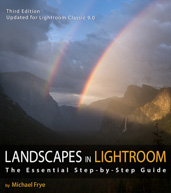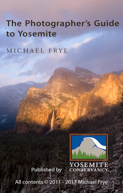In the Moment:
Michael Frye's Landscape Photography Blog
by Michael Frye | Jul 6, 2015 | Composition, Light and Weather
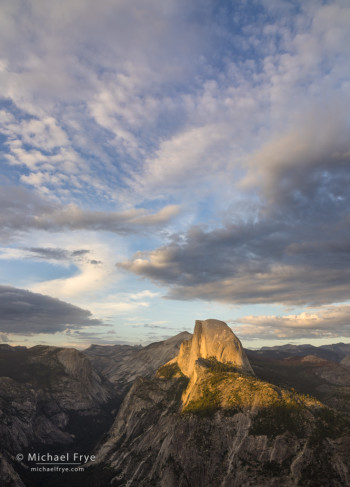
Half Dome from Glacier Point, late afternoon, Yosemite; for a brief moment the clouds formed a zigzag pattern above Half Dome.
Last week I mentioned that the weather forecast called for monsoonal moisture to move up into the Sierra Nevada from the south, with possible showers and thunderstorms. And sure enough, things unfolded pretty much as predicted. Rain was very localized; we got sprinkled on a couple of times at our house in Mariposa, but other nearby areas got dumped on when they received a direct hit from a thunderstorm.
Wednesday night brought thunder to the foothills near our house – that’s when I made the lightning photograph from my last post. But we saw interesting clouds all week. Claudia and I made two trips to Glacier Point, and I also photographed some beautiful moonlit clouds from our driveway, and made a trip into the lower foothills, where I found some striking, colorful sunbeams.
What do all these photographs have in common – aside from clouds? Patterns. All of these images have some kind of repeating pattern or design in the clouds.
(more…)
by Michael Frye | Jul 3, 2015 | Night Photography, Travels and Stories
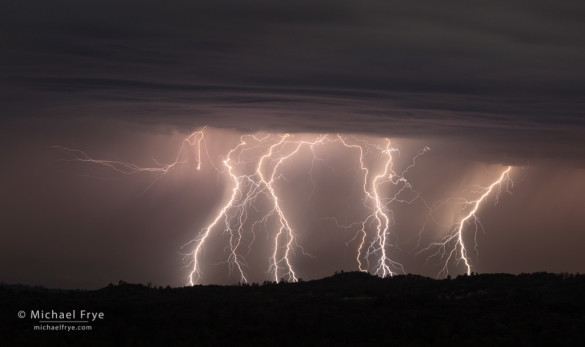
Lightning over the Sierra Nevada foothills, Mariposa County, CA, USA
We had some pre-Fourth-of-July fireworks here Wednesday night. At about 11:00 p.m. I let our dog Rider out before going to bed, and noticed flashes in the sky to the south. Sleep could wait! Claudia and I headed to a nearby viewpoint on Triangle Road, and saw lightning in three separate storm cells to the southeast, south, and southwest.
When watching thunderstorms you often only see cloud-to-cloud lightning, but on this night we could see some distinct bolts hitting the ground. I watched closely to try to determine where the most lightning activity was taking place. My first try didn’t work, but then another spot further to the right seemed to become more active, so I pointed my camera there, locked the tripod, and captured a series of 30-second exposures (each at f/9.5, 800 ISO). This photograph is a blend of five separate frames capturing seven or eight lightning bolts.
(more…)
by Michael Frye | Jul 1, 2015 | Reviews
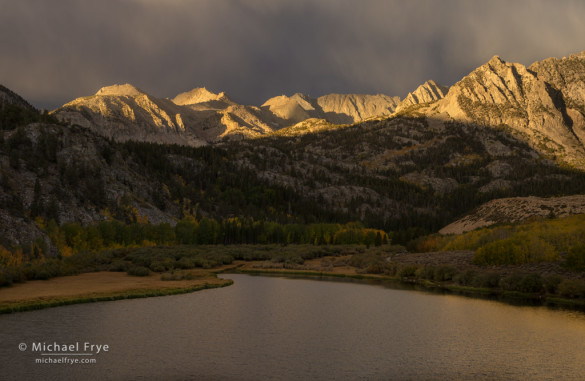
First light on peaks above North Lake, Bishop Creek Canyon, Inyo NF, CA, USA
In my recent post about high-resolution cameras, I stressed the importance of sharp lenses to get the most out of these 36+ megapixel sensors. But lens sharpness is an issue with any camera – at least when you start making larger prints. Even with a 16- or 20-megapixel sensor, lenses make a significant difference in large prints (16×20 inches and up). This is especially true in the corners; most professional-quality lenses are sharp enough in the center (at least with middle apertures like f/8 or f/11) for even a 36-megapixel camera. It’s the corners and edges that separate the decent lenses from the great ones. Those great ones are hard to find, and tend to be expensive.
Wouldn’t it be nice if you could fix imperfect lenses with software? Well yes, of course. But my experience with such fixes hasn’t been good. I’ve seen some great before-and-after examples online showing a blurry photo fixed with software, but when I’ve tried those programs myself I’ve invariably been disappointed. These cures tend to be just more-sophisticated sharpening methods, which may help a little, but if you apply more than a small amount things get really crunchy, or you see other weird artifacts. I can usually do just as well by selectively adding more sharpening to the corners in Lightroom or Adobe Camera Raw.
Piccure+
A few months ago I stumbled across another program that promised to help with fuzzy images, called Piccure+. I decided to download the free trial, and found that it worked surprisingly well. It’s not a magic bullet; there’s really no substitute for sharp lenses. But it can help with those soft corners, or overall softness caused by diffraction. Like any of these tools, it will definitely make the image look too crunchy if you overdo it, but I’ve been able to push the sharpening effect further in Piccure+ than with other software I’ve used, with good results and minimal artifacts.
(more…)
by Michael Frye | Jun 28, 2015 | Light and Weather, Yosemite Photo Conditions
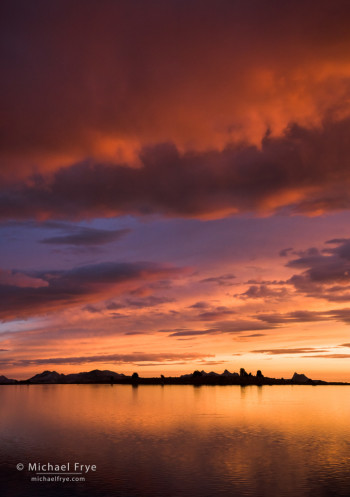
Sunset over an alpine lake, Yosemite
After a long stretch of blue skies, subtropical moisture is moving into the Sierra Nevada this week. That means clouds, thunderstorms, maybe a rainbow or two, and possibly even a chance to photograph lightning – in other words, photography weather! Here are the forecasts for Yosemite Valley and Tuolumne Meadows.
This is a typical weather pattern for the Sierra in summer. We’ll get stretches of clear blue skies, then subtropical moisture will move in for a few days, a week, or sometimes even longer, triggering afternoon showers and thunderstorms. Although some clouds and showers are likely this week, it’s hard to predict exactly what will happen on any given day, as the individual storm cells are usually small and localized, and can form and dissipate quickly. It helps to watch which direction the clouds are moving, and, if you can get an internet connection, keep an eye on weather radar. Of course you need to stay away from lightning, and avoid high, exposed ridges when thunderstorms are around.
(more…)
by Michael Frye | Jun 26, 2015 | Digital Darkroom
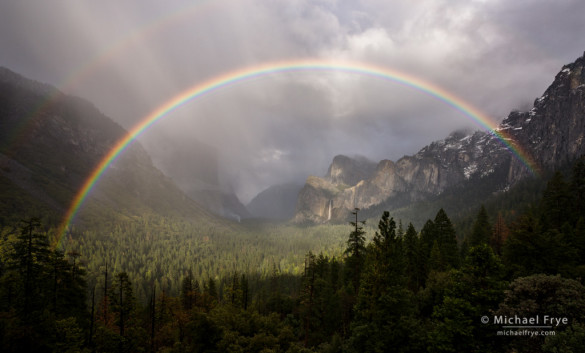
Rainbow over Yosemite Valley from Tunnel View – after applying the Dehaze control
Last week Adobe added an update to Lightroom CC, designated the 2015.1 release. It includes a couple of new features. The main one is a Dehaze slider, designed to reduce the appearance of atmospheric haze. It’s found in the Effects Panel of the Develop Module.
I’m usually skeptical of things like this. Is it really different than adding Contrast or Clarity? Well, yes, actually. Adobe says, “The Dehaze technology is based on a physical model of how light is transmitted, and it tries to estimate light that is lost due to absorption and scattering through the atmosphere.” I’m not sure how they do that exactly, but it seems to work more effectively than just adding Contrast or Clarity.
(more…)
by Michael Frye | Jun 21, 2015 | Travels and Stories
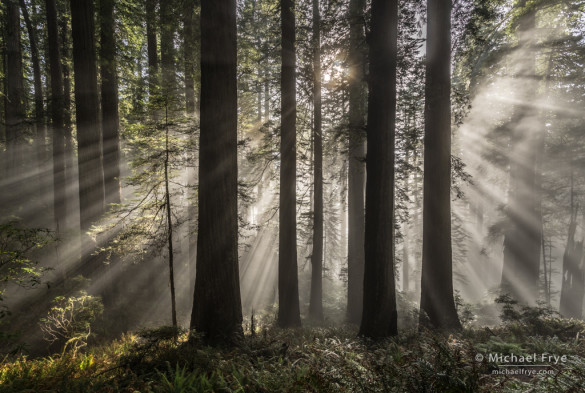
Sunbeams in a redwood forest, northern California coast
Today is the solstice, the official start of summer. It’s felt like summer for weeks here in the Sierra foothills. It’s been hot, and dry. Four (!) fires broke out near Mariposa and Oakhurst Thursday; fortunately they were all subdued quickly.
(more…)
by Michael Frye | Jun 17, 2015 | Announcements
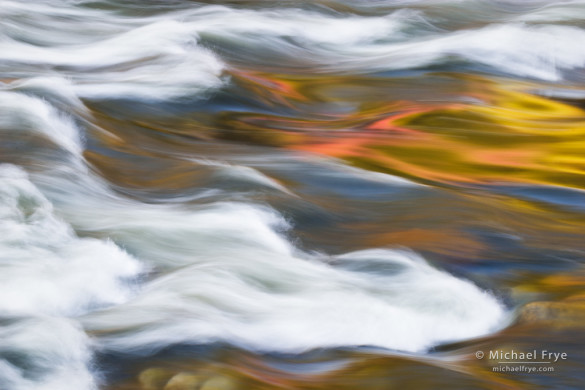
Redbud reflection in the Merced River (part of the portfolio)
I’m honored to have a portfolio of my images, plus an in-depth interview, included in the latest issue of Photograph digital magazine from Craft & Vision. Regular readers have probably seen most of the images in the portfolio before, but it’s nice to view them all together, and I thought the questions the interviewer asked were interesting and thought-provoking.
There are three other portfolios in this issue – a fascinating and diverse collection. I enjoy looking at different kinds of photography, and especially liked Jordan Manley’s portfolio, as it blends elements of sports, photo-journalism, and landscape in an artful way.
(more…)
by Michael Frye | Jun 14, 2015 | Light and Weather
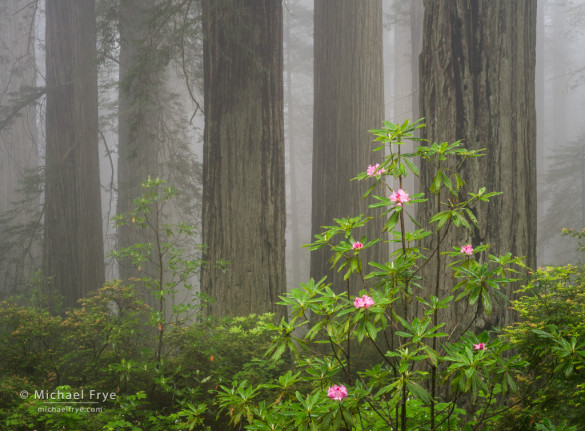
Redwoods and rhododendrons along the northern California coast
As promised, here are some more images from our time up in the redwoods. I just love this area, with all its damp, primeval moodiness. Claudia and I were there for almost two weeks, and experienced a great variety of weather, including fog, overcast, sun, clouds, and some colorful sunsets. And on the last day of the workshop we went to a beach near Trinidad during a minus tide, where we found some beautiful pools and reflections, and easy access to starfish and other tide-pool creatures.
The variable weather required flexibility. Anyone who’s taken a workshop with me knows that I rarely tell the group very far in advance where we’ll be going. I’d rather wait until the last minute to assess the weather, then go where conditions seem most promising.
(more…)
by Michael Frye | Jun 12, 2015 | Light and Weather, Travels and Stories
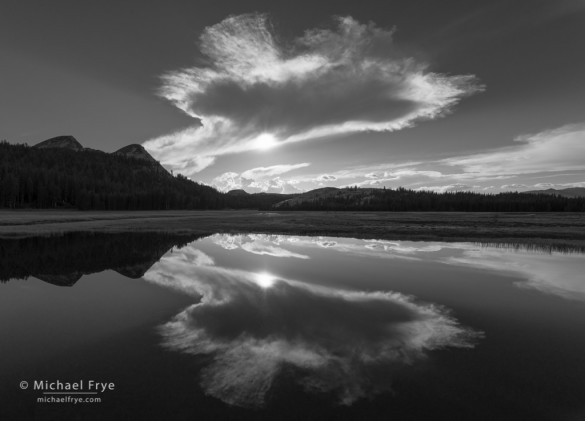
Cloud formation reflected in a pond, Tuolumne Meadows, Yosemite NP, CA, USA
Claudia and I did head up to the high country yesterday afternoon, and found some great clouds. We drove through a nice downpour near Crane Flat, then continued up to Tuolumne Meadows, where I photographed a beautifully-shaped cloud reflected in one of the ponds (above). Later a storm cell formed over the peaks to the east, creating another dramatic cloud formation (below). That cell gradually dissipated, but some clouds still lingered until sunset (the last photo below). It was a really fun afternoon – I’m glad I finally made it up there!
(more…)
by Michael Frye | Jun 11, 2015 | Light and Weather, Photography Tips
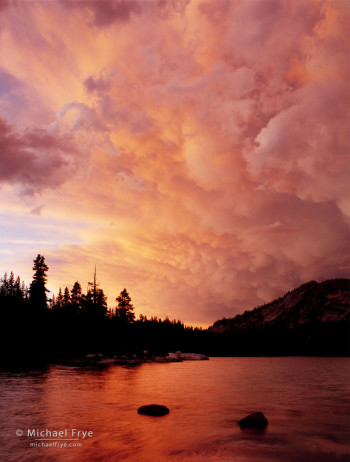
Sunset clouds over Tenaya Lake, Yosemite NP, CA, USA
I haven’t had many opportunities to get into the Yosemite high country since Tioga Pass opened, but I hope to head up there soon – maybe even this afternoon, since it looks like some clouds are building. Clouds and thunderstorms always make the summer days in the high country interesting, and potentially photogenic.
This photograph, from July of 2003, shows one of the most spectacular cloud formations I’ve ever seen. Claudia and I were in Tuolumne Meadows, and watched and photographed a thunderstorm move through from east to west. I hoped that after the storm passed we’d see some interesting light, but no such luck – it was just overcast. So I decided to follow the storm, and drove west toward Tenaya Lake.
We stopped near the eastern end of the lake. I got out of the car and looked out to the west, but the scene didn’t look very interesting in that direction. Then I looked over my shoulder. Holy crap! I saw this turbulent line of clouds, lit by the setting sun, and knew immediately that I was in the wrong spot – I needed to be on the other side of the lake.
(more…)

















